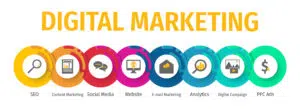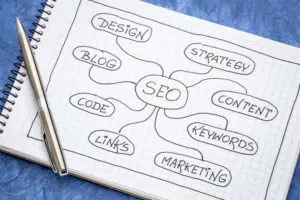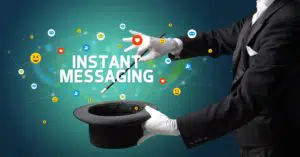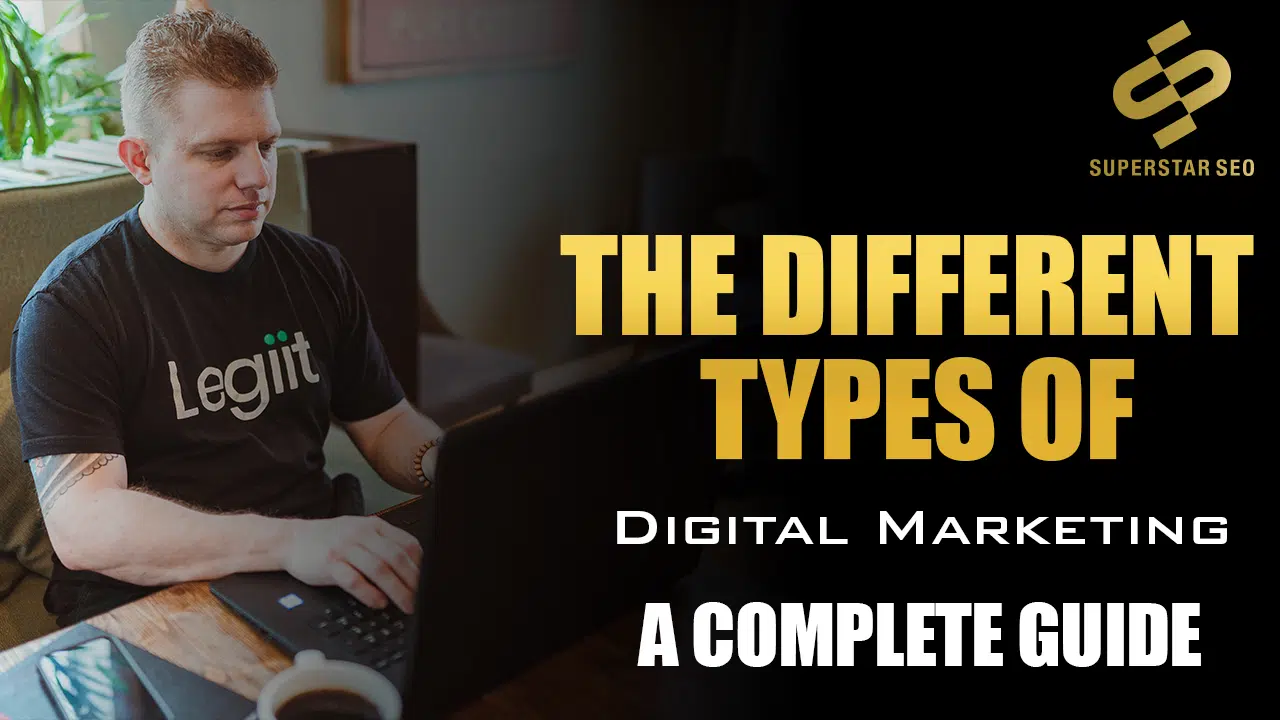Types Of Digital Marketing
Widespread technology and internet connectivity have, without a doubt, changed how we live, work, and do business. Thanks to this digital revolution, it has become possible to buy and sell without ever leaving your home. Therefore, it’s no longer enough for businesses to sit and wait for customers to come to them. Instead, brands have had to adapt and shift to reaching out to their target market right where they are, hence the rise of digital marketing.
What is digital marketing?

Digital marketing refers to all forms of marketing activities done through digital channels, like mobile phones, computers, laptops, and other electronic devices. New-age digital marketing is typically done over the internet through emails, Youtube and Google ads, and social media. However, older methods like TV and radio broadcasts are still in use.
Thus, pretty much all forms of marketing today fall under digital marketing. And unlike in the past century, where marketing was only available to the big corporations, digital marketing can be done by businesses of any size and budget. This is because the internet has significantly cut down advertising costs for businesses and individuals alike.
Other advantages of digital marketing include;
It has a wide reach
As a wise man would say, nobody is safe from the internet, and thus, digital marketing. This is perhaps digital marketing’s biggest appeal. You can quite easily get to anyone, whether they live next door or on the other side of the globe.
It is diverse
Digital marketing is available in a wide range of options, allowing businesses to diversify their marketing approach with ease. You can use various platforms, including your website, social media accounts, messaging apps, and even the local TV and radio stations, to push your message to consumers.
It is flexible
The diversity of digital marketing comes with a whole lot of flexibility. Businesses can personalize their marketing approach depending on their venture and market. They can also conveniently tweak their strategy depending on the prevailing and/or projected market conditions.
It’s easy to track performance
Digital marketing is easy to track and analyze, especially when done over the internet.
Marketers have tools that use clicks and conversions to monitor the performance of their digital marketing campaigns.
Social media platforms like Twitter, Meta, and Google offer analytics that measure impressions, engagement, and comments on your campaigns.
Therefore, it is easier to come up with an effective digital marketing strategy.
It works
Put all the above together, and you have a marketing strategy that works effectively. In fact, some forms of digital marketing promise well over 1000% return on investment (ROI) if done correctly.
Common Types of Digital Marketing and How they Work
Here is a closer look at ten of the most common digital marketing strategies and how marketers use them to achieve successful campaigns.
Content Marketing

You’ve probably heard the phrase content is king one too many times. What’s the hype?
Content marketing uses relevant and useful content to increase brand awareness and promote your business’ value. Rather than shove your products or services in the faces of potential customers, this approach leverages their hunger for information and stories to drive conversions.
“Content” here means anything from blog posts, brochures, and ebooks, to videos, podcasts, case studies, infographics, and templates. These provide your audience with the information they want while steadily influencing them to take the desired action towards becoming a customer. This may be making a purchase, contacting you for more information, or signing up for an email list.
When implementing a content marketing strategy, it’s important to focus on providing value to the consumer. It’s your main goal, as it greatly helps build a sustainable and trusting relationship with your audience. The relationship, in turn, leads to more conversions and/or sales.
Content marketing strategy is also a long-term strategy whose aim is to bring the user back to the seller multiple times. That’s why content marketers should build a library of content by publishing more articles, videos, or podcasts for their audience. This helps establish you as an authority within your niche and boosts your reputation in the market.
All in all, content marketing works pretty well with other forms of digital marketing. You can incorporate SEO to bring in more traffic and share the content on social media and email marketing campaigns.
Search Engine Optimization (SEO)

90% of internet traffic comes through searches using search engines like Google. In fact, 63,000 searches are made every second, creating a huge pool of potential customers for businesses to reach out to. This has made Search engine optimization (SEO) one of the most crucial forms of digital marketing for websites and e-commerce stores.
SEO uses keywords to help rank a page as high as possible in search engine results pages (SERPs). These keywords are generally words and phrases used to search for information, products, and services online.
Thus, SEO marketing works in close symbiosis with content marketing. The SEO expert must cooperate with the copywriter to generate content around keywords consumers use when searching the internet. This is done in the hope that when the search engine crawls and indexes the webpage, it will rank it among the pages most relevant to the keywords.
Why is this important? Well, SEO brings in organic traffic, which has a higher conversion potential than paid traffic. So, the better your SEO strategy, the more organic traffic (without ads) your website attracts, the more conversions you make. And this translates to commercial success, especially if you’re selling products and/or services through your website.
Also, 91% of all web traffic is shared among first-page SERPs. In fact, the highest-ranked search engine results page gathers around 32.5% of web traffic. Therefore, a page needs to rank high up in the SERPs. The higher up you rank, the more organic traffic you’ll receive.
On the flip side, SEO is quite difficult to get right. It’s no longer just enough to bundle up keywords and publish your posts. Instead, you have to effectively combine keyword research with content creation, backlink building, local SEO, and website optimization (how fast or slow your website is, especially mobile devices).
Google and other search engines also constantly update the algorithms used to crawl, index, and rank web pages. These changing metrics make it difficult for the average business owner to improve their website’s SEO. Fortunately, they can always hire an SEO strategist if the tasks prove too tedious.
Search Engine Marketing (SEM)

Search engine marketing (SEM) is the opposite of search engine optimization (SEO). While the latter focuses on generating organic traffic, SEM uses paid advertisements to increase traffic from search engines. These usually appear as ads on top SERPs but are differentiated from organic search results by two things;
They appear before any organic search results
They usually have an ‘Ad’ label
SEM is not as effective as SEO. This is because many people dislike ads and, thus, will often ignore the paid advertisement and scroll down to the organic search results. However, it can still work well enough when deployed correctly. In addition, it’s actually easier to create targeted paid ads based on the relevant keywords and searchers’ location. This allows digital marketers to target potential customers from a specific area or demographic.
You can also use SEM to steal some website traffic from your competitors. This is done by targeting specific competitor keywords in your search result ads. Thus, search engine marketing works best if you’re entering a competitive niche relatively late. Even then, it shouldn’t be used as a replacement for search engine optimization.
Pay Per Click (PPC)

Pay-per-click (PPC) is an advertising model where you pay for the number of clicks on your ad. You put up an ad while incurring little or no upfront costs. Then, during the period that the ad is up, you will pay for the specific number of customer clicks on it. If no one clicks on it, you don’t pay.
Depending on the industry and targeted keywords, the average click on a PPC ad costs the business between $1 and $3. However, there are corporations out there willing to pay as much as $50 per click, especially in industries with highly competitive keywords, like insurance.
Overall though, the relatively low costs of PPCs make them appropriate for small businesses with a limited budget. As a result, they have become one of the most popular advertising models in digital marketing.
Note that PPC advertising can extend to other forms of digital marketing. For instance, it falls under search engine marketing (SEM) when used on search results ads. It can also be used in video (content marketing) and affiliate marketing.
Social Media Marketing (SMM)

With active users numbering in the billions, social media has become one of the best digital marketing platforms. These platforms provide a wide pool of potential clients for all kinds of businesses. Also, businesses have no limit to who they can reach with their ads, as long as the marketing campaigns remain within the stipulated community guidelines.
Perhaps the main reason for social media’s appeal to digital marketers is the pool of potential clients. SMM is everywhere in the three most popular social media networks; Meta (2 billion active daily users), Instagram (500 million active daily users), and Twitter (300 million active users).
SMM is also easily accessible and affordable, even for small businesses on a low budget. They don’t have to shell out money to gain followers and run successful campaigns. Rather, the task is to strategically grow their social media following and use it for marketing their goods and services.
Social media marketing also allows for two-way communication between businesses and their customers. This usually happens in the comment section or even in the DMs.
Overall, the key pillars for social media marketing are strategy, planning and publishing, listening and engagement, analytics and reporting, and advertising;
Strategy: First, the digital marketer determines the goals of the marketing campaign and the target market and selects the social media channels to be used.
Planning and Publishing: They then draft plans on which content will be shared on which social channel before publishing the content. Unfortunately, many businesses make the mistake of assuming that the work is over after publishing.
Listening and Engagement: Marketers go through the comments to monitor what their audience says about the social media posts and business. While at it, they respond to queries and engage in constructive conversations with their customers in the comment section.
Often, customers will head straight to the DMs to respond to the business’ posts and make inquiries/purchases. These direct messages should not be ignored as they’re an opportunity to generate more leads. Other ways to improve on lead generation include;
Analytics and reporting: Some social media platforms provide crucial data on engagements and interactions on your posts. These are not just numbers; they help you gauge the success or failure of your marketing campaigns. If you want more detailed information and data, you may need to adopt social media analytic tools like Sprout Social, Curate, HubSpot, etc.
Advertising: This step is optional and involves purchasing ads to compliment your marketing campaign.
The success of your social media marketing efforts largely depends on the number of your followers and your ability to create shareable content. This is because a large follower base lets you speak directly to as many people as possible. On the other hand, sharable content means that your audience will do much of the promotion on your behalf, further spreading your message to people not following you.
Affiliate Marketing

Affiliate marketing is an arrangement between an online retailer and a digital marketer, where the marketer earns a commission making conversions. The marketer is usually a content creator who runs a blog or posts videos on Youtube and/or social media. They will often;
Provide their readers/followers with a unique discount code. This technique is pretty common among YouTubers and other content creators. Every user that makes a purchase using the discount earns the content creator some commission.
Link the business’ website and products to their website. Each time a reader/subscriber clicks and purchases via the link, the online retailer pays the marketer a commission.
With affiliate marketing, businesses don’t need to have a large following. Rather, the content creators do the advertising on their behalf to their audiences. This allows the business to reach a new target audience and consumers in niche communities. Also, they only have to pay for actual conversions (similar to PPC), making it a relatively cheap and affordable marketing tool.
On the other hand, affiliate marketers get to earn passive income while doing what they enjoy. Some even earn thousands of dollars every month this way, making affiliate marketing one of the most lucrative types of digital marketing.
Most affiliate marketers work with Amazon- in the Amazon Associates network- eBay, Shopify, Best Buy, and similar large-scale retailers. These e-commerce sites act as middlemen between the sellers and the affiliate marketers.
However, there are businesses with affiliate programs. Rather than use a middleman like Amazon and Shopify, they work directly with affiliate marketers. Many influencers fall under this category, although they can be categorized as their own form of .
On the venture’s side, businesses must employ creators who match their goods/services. The person must be an established and trusted figure in their niche. For instance, hiring someone with little knowledge of tech to act as an affiliate marketer for a tech company is a recipe for failure.
Influencer Marketing

Influencer marketing uses popular social media figures to promote a business’s goods and services. These influencers may be niche-focused or just trusted and admired by the general community. As such, they get gigs where they regularly post a business’s goods and services in exchange for an agreed fee.
There are three types of influencers on the internet; Micro, macro, and mega influencers. Micro-influencers have anywhere from ten thousand to a hundred thousand followers. They are typically niche-focused and demonstrate a level of expertise that’s made them a trusted figure within their community. Their relatively small audience makes them the cheapest influencers to work with
On the other hand, micro-influencers have six-figure followers, from 100,000 to 999,999. These influencers are mostly social media stars and usually have considerable expertise in a particular niche. As a result, they provide a wider reach than micro-influencers, and their services cost more.
Mega influencers are usually celebrities with millions of followers. They include artists, athletes, comedians, actors, and models, although some social media stars have also attained this level. These influencers provide the widest reach, but depending on your product, you may or may not get as many clients as you’d like.
They also have exorbitant rates, charging tens of thousands of dollars for a single post. As a result, mega-influencers are exclusively used by big corporations with millions if not billions of dollars worth of marketing budgets.
All in all, businesses must be careful to pick influencers that appeal the most to their desired target audience. They should also be wary of influencers who bought followers. Such influencers typically have an inactive follower base, comprising mostly bots.
Email Marketing

Email is still one of the most effective techniques. According to Hubspot, the average return on investment (ROI) for email marketing is 3,800%. This means that for every dollar spent, you get back $38.
Like content marketing, email marketing is typically used to provide value to an audience with the hope of converting them into customers. It enables businesses to personally promote their brand while building valuable relationships with their customers. It’s also a great way to gain feedback from clients.
Email marketing comes in many forms, including confirmation emails, thank-you notes, and the most popular of all; brand newsletters. These are used to give clients regular updates, including news on offers, discounts, and coupons. Businesses also send emails when launching new products or services, hosting events, moving/opening to a new location, and revamping their websites.
But first, digital marketers have to build an email list. Most people build theirs using CTA buttons at the end of blog posts and articles on their website. These calls to action prompt their readers to sign up for a email newsletter or create a brand account using their email account. Some businesses go a step further and buy their email lists, although doing so is discouraged.
After securing your list, you now have to create engaging email content for your audience. This you can either do yourself or hire a professional email marketer. Some of the top benefits of hiring an email marketing pro include;
They are skilled in creating compelling campaigns
They know how to analyze customer interactions data on the email campaigns
Professionals tend to make strategic decisions based on this data.
Generally, marketers monitor the open rate (percentage of recipients who opened the email) and the click-through rate (number of recipients who opened and followed a link in the email). These are key indicators of the success of an email marketing campaign. Some of the things you can do to increase your open and click-through rates include:
Craft enticing subject lines that tap into the desires of your audience.
If you’re selling something on offer, create a sense of urgency that invokes the fear of missing out. Imply that time is running out on the offer/deal or that there are only a few offers left.
Personalize your email by incorporating the recipient’s name into the subject lines.
Allow your recipients to set their preferences, i.e., how often they want to receive your emails.
Instant messaging marketing

Direct messaging marketing (mobile marketing) has emerged with the widespread use of messaging platforms like Whatsapp, Messenger, Telegram, and iMessage. This technique is pretty simple to launch; set up a messaging profile on your favorite platform, use your blog to get customer contact information, and start messaging.
Another benefit of instant messaging lies in its directness. Since you’re directly addressing potential customers, you can expect quick and honest responses from them. It’s also the cheapest form of . I mean, how much does it cost to send a message to someone on Whatsapp?
And speaking of Whatsapp, the platform has a special messaging app for businesses; Whatsapp Business. The app has various features that allow entrepreneurs and marketers to promote their products and services to their contacts.
However, note that instant messaging can be a nuisance if you’re not careful. It’s a lot like the telephone salesman of old; easy to convince and easier to annoy. Therefore, make sure that you personalize your messages and, most importantly, keep them short and snappy. It would be best if you also tried to inspire action by using CTA buttons.
TV&Radio

TV is one of the oldest forms of digital marketing in existence. For decades, businesses and corporations have been spending millions of dollars every year to get their commercials on television. This is because millions of people are watching television at any given time, especially from 6 pm to 9 pm.
However, television advertising is not as widespread as it once was. The internet has enabled many people to switch to streaming services and illegal downloads and thus, avoid ads. And considering how much it costs to produce and air TV ads, companies are slowly cutting down on their TV marketing spend.
Radio advertising is the earliest digital marketing tool ever invented. In fact, some of the most iconic advertisements in marketing history came through the radio. Its appeal lies in its wide reach and relatively affordable cost of running an ad through the airwaves. It’s also relatively easy and cheap to produce radio ads; all you need is good sound equipment, a good script, and an equally talented voice actor.
However, the technology’s age also means that radio is often overlooked as a digital marketing option.
Key Takeaway: Marketing analytics
Except for TV and radio, most forms of digital marketing channels are highly trackable and measurable. This is possible through analytics, which allows marketers to track audience behavior at a surprisingly detailed level. Today, you can check how much time users spend on your website, how often they open your emails, how many times they follow a link, how many people finish your videos, and so on.
But in our marketing environment, it’s not enough to just look at the data and move on to your next project. At the start and finish of every campaign, marketers must understand what the data means and form a digital marketing strategy around it. This allows them to adapt their marketing messages to suit consumers and, in the process, boost the brand value and image.
What is the best option?
Digital marketing is diverse, and every method delivers. Also, most of these digital marketing tools work best in symbiosis with one another, meaning there is no single best digital marketing option in existence. Take, for instance, how content marketing goes hand in hand with SEO, website optimization, and social media marketing. Take away one of these, and it won’t deliver as exceptionally as before.
Therefore, any of the above options can suit your business. What works best for you will depend on your marketing budget, target demographic, and overall message.





